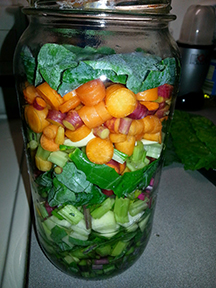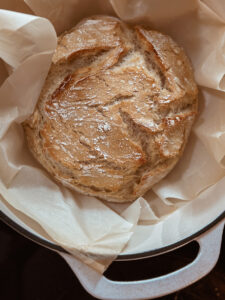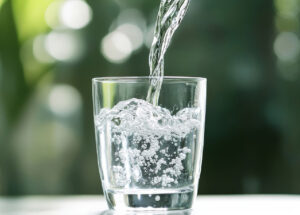Because the ingredient list in commercial instant mashed potatoes is longer than my arm and mostly completely unpronounceable, and because we NEVER eat the whole bag of potatoes before they become something from a horror movie that gives me nightmares when I look into the potato box, I dehydrate a lot of spuds in various forms.
Costs to Make Potato Flakes
One 10 pound bag of potatoes (conventionally grown): cost $2.98*
Gas for the stove and electricity for the dehydrator/grinder/lights so I can see, water to wash/boil/rinse with, fuel and maintenance portion for the grocery run during which I acquired these items, amortization cost of items used during the production: =/-$1.00
(Frankly, it’s less, but I’m gonna just be lazy about it, this is about dehydrating, not higher math with fractions)
Total cost for homemade potato goodness: $3.98.*
First thing I did was to decide what I want these potatoes to be. We LOVE, and I mean LOVE mashed potatoes. It’s our go-to food when we want comfort food. There is just nothing out there that can beat mashed potatoes and chili for comfort when you need it. So I assigned about 2/3 of the bag of potatoes to potato flakes.
We also adore latkes/Kartoffelpuffer/potato pancakes, or whatever you call them in your home. So the remaining 1/3 of the 10 pound bag will be shredded and dried for latkes.
POTATO FLAKE MAKING PROCESS
1. Prep the potatoes.
I boiled the potatoes that are going to be flaked until they were done, and let them cool.
While the boiled potatoes cool, peel the raw potatoes destined for Latke Land. Shred the raw potatoes into a large bowl of cold water. Put the peels into a separate bowl of cold water. I’ll explain and show you why later.
Set enough water on to boil to blanch the shredded spuds. Grab the shredded potatoes out of water. Squeeze and let them drip drain as much as possible. Put the potatoes into boiling water to blanch for a few minutes (about 2 minutes for fine shred, 5 minutes for thicker shreds). Scoop them out, plunge into ice water to stop cooking, and drain.
While waiting for the water to boil for the shredded potatoes, I peeled the potatoes for the soon-to-be potato flakes.
There is a bit of juggling at this point in the process. I eventually ended up with peeled boiled potatoes, a bowl of shredded, cooled and blanched potatoes, and a bowl of raw potato peels.
Take the leftover shred water and combine it with the water the peels are sitting in, and make sure to get the sediment into the combined solutions. This is potato starch, used for thickening sauces. Remove the peels, leaving behind the sediment. Set aside. You’ll deal with this once you get the potato batches dehydrating.
2. Start the dehydration process
Start running dehydrator at appropriate temp (I try for about 130 degrees, I like to go a bit slow).
Drain shredded potatoes, and leave them to cool a bit.
Peel boiled whole potatoes while the shredded potatoes drain and cool.
Put shredded, drained, slightly cooled potatoes onto dehydrator tray. I use salad forks for the transfer. Also, I put the shreds on a fruit leather (friut roll-up) tray in my dehydrator because I shred them fine enough to fall through the other trays. Put the filled tray into the dehydrator, on the bottom rack.
Begin dehydrating shredded potatoes.
Rice the peeled, boiled potatoes, or put through a food mill.
Mash the boiled potatoes a bit more with a fork.
Spread the mash on fruit leather trays, begin dehydrating.
By this point, the bowl with the combined batches of potato water should have settled and cleared. Pour off the by now clear water from the potato starch. Don’t pour off the liquid starch.
Add more water and swish it around the bowl, making sure the starch is all in solution. pour the whole thing through a strainer into another bowl to get the bigger bits out, discard bits. Let settle, pour off water, add fresh water, let settle, pretty much repeat until no more floaty bits come up, then pour off the clear water and let the starch dry, then break it up and put in an airtight container, use to thicken delicious gravies.
Enjoy the rest of the day, doing whatever it is you do, while the dehydrator does its thing pretty much overnight. I cleaned the kitchen, played with my chickens, slept, cleaned the living room, did some laundry, and drank obscene amounts of coffee.
In about 16 hours, depending on humidity, temperature, thickness of items to dry, begin unloading dehydrator.
Tipping the trays upside down over a bowl has proved to be the easiest for me with both types of dried potatoes.
SHRED
- Tip out shred into bowl, break up and fill clean canning jar.
- Put oxygen absorber into jar, seal with vacuum sealer. (Or put into other airtight container, if you like. the OX-ex and vacuum are completely optional (but I *do* recommend them).
- Label and date your product. Trust me.
Mashed Potatoes
- Put mash sheet into bowl, break up enough to fit into grinder
- Grind mash into powder, I run this through a flour sifter and basically keep grinding until it’s all fine.
- Seal jar in whatever manner you decide. I put mine in the canning jar.
BTW: Here is why I dehydrate: What you see is a 10lb bag of potatoes:
To re-hydrate the potatoes:
I put the shred in a bowl of hot (not boiling) water for about 15 minutes, drain and cook as though they are fresh.
The mashed are even simpler: 1 cup of powder to 3 cups of boiling water, let sit for a minute, season (mmmmm, butter and garlic), enjoy.
I don’t know exactly how much money this effort is saving us, because I cannot quantify the financial health benefits from eliminating artificial ingredients and because I haven’t bought potato starch in years, but I do know that just that little bitty jar of instant mashed potatoes would cost more to buy than I spent on all of this combined and it would be laced with stuff we don’t want in our food.
I am not going to go into how much my labour is worth, since what you see here represents no more actual hands on time than preparing mashed potatoes from scratch for dinner and definitely less time than it would take us if we ran out every time we want one of these ingredients for a meal or snack.
That’s all I have for now.
Happy Pinching
*Costs mentioned were from when this article was first written and may have changed.


































Thanks for this article–it will give us a way to store the larger portion of our potato crop (we finally had a decent amount of success).
May I ask exactly what you mean by ‘grinder’? Are you using a grain mill? I ran our dried ‘taters for mash through a pretty powerful blender and got small chunks but very little powder. And forget the mortar and pestle! Those bits are tough.
Joanne Galley, I use a blender and it does a good job, I know other people who use a coffee grinder as well but I would imagine while giving use a finer ground, would have to be done in smaller batches. Happy preserving!!!
Well, that made no sense.
In future, please divide the steps per results because this to a newcomer, cannot be deciphered.
I had a hard time following it as well
Hi
How long potato flakes can last?
Thank you
its just plain old mashed potatoes dried in a dehydrator. then ground. shredded: grate, parboil. dehydrate. starch: carefully pour off clear water to save the sediment at bottom of bowl. dehydrate. hope that helps
Oh now this I enjoyed reading. Thank you. I have been thinking of expanding what I dehydrate and this was great. Now I tell you saving the potato starch; oooh yes indeed you are talking my language save all we can and use it!
Thank you for sharing your method!! I have done this twice now and am about to make my third batch. I use potato flakes for my sourdough starter, and since covid hit in early 2020 it has become increasingly difficult to find plain potato flakes at my local grocer. This method is easy-peasy, why ever go back?! I do have one question about the peels from the cooked potatoes. Do you add them to the water with the raw peels? Is it necessary to peel them at all or is that just your preference? Again, many thanks!